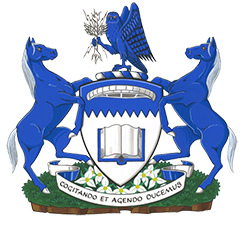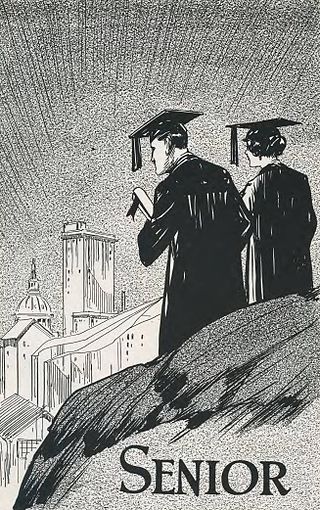Related Research Articles

A primary school, elementary school or grade school is a school for primary education of children who are four to eleven years of age. Primary schooling follows pre-school and precedes secondary schooling.

A student is a person enrolled in a school or other educational institution.
In the education systems of England, Northern Ireland, Wales, Jamaica, Trinidad and Tobago and some other Commonwealth countries, sixth form represents the final two years of secondary education, ages 16 to 18. Pupils typically prepare for A-level or equivalent examinations like the IB or Pre-U. In England, Wales, and Northern Ireland, the term Key Stage 5 has the same meaning. It only refers to academic education and not to vocational education.

A CEGEP, also written cégep, CÉGEP and cegep, is a publicly funded college providing technical, academic, vocational or a mix of programs; they are exclusive to the province of Quebec's education system. A loanword from French, it originates from the French acronym for Collège d'enseignement général et professionnel, sometimes known in English as a "General and Vocational College"—it is now considered a word in itself.

Franco-Ontarians are Francophone Canadians that reside in the province of Ontario. Most are French Canadians from Ontario. In 2016, the Government of Ontario calculated that there are approximately 622,415 francophones residing in the province. The majority of Franco-Ontarians in the province reside in Eastern Ontario, Northeastern Ontario, and Central Ontario, although small francophone communities may be found in other regions of the province.

Education in Canada is for the most part provided publicly, and is funded and overseen by provincial, territorial and local governments. Education is within provincial jurisdiction and the curriculum is overseen by the province. Education in Canada is generally divided into primary education, followed by secondary education and post-secondary. Within the provinces under the ministry of education, there are district school boards administering the educational programs.
The Ontario Academic Credit (OAC) (which may also be known as 12b) (French: Cours préuniversitaire de l'Ontario or CPO) was a fifth year of secondary school education that previously existed in the province of Ontario, Canada, designed for students preparing for post-secondary education. The OAC curriculum was codified by the Ontario Ministry of Education in Ontario Schools: Intermediate and Senior (OS:IS) and its revisions. The Ontario education system had five years of secondary education, known as Grade 13 from 1921 to 1988; grade 13 was replaced by OAC for students starting high school (grade 9) in 1984. OAC continued to act as a fifth year of secondary education until it was phased out in 2003.

Ontario Tech University (OTU), also known as Ontario Tech, is a public research university located in Oshawa, Ontario, Canada. The university's main campus is located on approximately 160 hectares of land in northern Oshawa, while its secondary satellite campus is situated in downtown Oshawa. The university is a co-educational institution that operates seven academic faculties.

A vocational school, trade school, or technical school is a type of educational institution, which, depending on the country, may refer to either secondary or post-secondary education designed to provide vocational education or technical skills required to complete the tasks of a particular and specific job. In the case of secondary education, these schools differ from academic high schools which usually prepare students who aim to pursue tertiary education, rather than enter directly into the workforce. With regard to post-secondary education, vocational schools are traditionally distinguished from four-year colleges by their focus on job-specific training to students who are typically bound for one of the skilled trades, rather than providing academic training for students pursuing careers in a professional discipline. While many schools have largely adhered to this convention, the purely vocational focus of other trade schools began to shift in the 1990s "toward a broader preparation that develops the academic" as well as technical skills of their students.
Twelfth grade is the twelfth year of formal or compulsory education. It is typically the final year of secondary school in most of the world. Students in twelfth grade are usually 17-18 years old. Some countries have a thirteenth grade, while other countries do not have a 12th grade/year at all.

The Ontario Student Assistance Program (OSAP) (French: Régime d'aide financière aux étudiantes et étudiants de l'Ontario ) is a provincial financial aid program that offers grants and loans to help Ontario students pay for their post-secondary education. OSAP determines the amount of money that a student is eligible to receive by considering factors such as tuition, course load, and the financial resources of the student. More than 380,000 students – more than half of all full-time students –received student financial aid in 2014-15.
A credit is the recognition for having taken a course at school or university, used as measure if enough hours have been made for graduation.
The Education Quality and Accountability Office (EQAO) is a Crown agency of the Government of Ontario in Canada. It was legislated into creation in 1996 in response to recommendations made by the Royal Commission on Learning in February 1995.
The Ontario Secondary School Diploma (OSSD) is a diploma granted to secondary school graduates in the Canadian province of Ontario. It is part of the publicly-funded province-wide school system. It is awarded to all students who complete the Ontario education curriculum, including students in Special Education, the TOPS program, MaCS program, IB Program, and other focused secondary school programs.
Thirteenth grade, grade thirteen, or super senior year is the final year of secondary school in some jurisdictions. In some locales, receiving a high school diploma or equivalent is compulsory. In others, receiving a high school diploma is not required but may be a prerequisite to enrolling in certain post-secondary institutions. Students who are in thirteenth grade are usually 18-19 years old.
Education in Ontario comprises public and private primary and secondary schools and post-secondary institutions. Publicly funded elementary and secondary schools are administered by the Ontario Ministry of Education, while colleges and universities are administered by the Ontario Ministry of Training, Colleges and Universities. The current respective Ministers for each are Stephen Lecce and Ross Romano. The province's public education system is primarily funded by the Government of Ontario, with education in Canada falling almost entirely under provincial jurisdiction. There is no federal government department or agency involved in the formation or analysis of policy regarding education for most Canadians. Schools for Indigenous people in Canada with Indian status are the only schools that are funded federally, and although the schools receive more money per individual student than certain provinces, the amount also includes the operation and maintenance of school facilities, instructional services, students supports and staff. Most provincial allocations per students do not include the maintenance and operation of buildings, as most provincial governments offer additional grants.

The term senior, in regard to education, has different meanings depending on the country.

In Canadian English, the term college usually refers to a career college, technical, trades, community college, college of applied arts or applied technology, or an applied science school. These are post-secondary institutions granting apprenticeships, citations, certificates, diplomas, and associate's degrees.

Blyth Academy is a Canadian private education company founded in 1977 by Sam Blyth and is now part of the Globeducate network. Based in Toronto, Ontario, Blyth Academy is a chain of private secondary schools and academic credit programs in Canada and abroad. Primarily located throughout Ontario, Blyth Academy also has schools in the United States, Florence (Italy) and Qatar, in addition to an online program and study-abroad programs that offer academic credit. In 2018, Blyth Academy founder Sam Blyth sold the organization.
A high school diploma is a diploma awarded upon graduation of high school. A high school diploma is awarded after completion of courses of studies lasting four years, typically from grade 9 to grade 12. It is the school leaving qualification in the United States and Canada.
References
- ↑ Colgan, Greg (1 March 2017). "Four Woodstock wrestlers and eight in total from Oxford County will take part in OFSAA wrestling". Woodstock Sentinel-Review. Postmedia Network. Retrieved 16 July 2019.
- ↑ Pyette, Ryan (1 January 2019). "South's 'beast' still deciding where his football talents will take him next". Postmedia Network. London Free Press. Retrieved 16 July 2019.
- ↑ Brady, Patrick; Allingham, Philip (18 November 2010). "Pathways to university: The "Victory Lap" Phenomenon in Ontario" (PDF). Canadian Journal of Educational Administration and Policy (113).
- ↑ "Liberals say 82% of high school students graduate". CP24. BellMedia. 8 March 2012. Retrieved 16 July 2019.
- ↑ Brown, Louise; Rushowy, Kristin (27 March 2012). "Ontario budget: Hard lessons for teachers, some students". The Toronto Star. Torstar Corporation.
- ↑ "Four-Year Secondary School Program – Thirty-four credit Threshold". Ontario Ministry of Education. Queen's Printer for Ontario. 25 April 2013. Retrieved 28 June 2019.
- ↑ "High school 'victory laps' cost province $22 million". CBC News. Canadian Broadcasting Corporation. 29 March 2012. Retrieved 16 July 2019.
- ↑ "Quick Facts: Ontario Schools, 2016–17". Ontario Ministry of Education. Queen's Printer for Ontario. 2 April 2019. Retrieved 16 July 2019.
- ↑ "Attendance Rights". Justice for Children and Youth. Canadian Foundation for Children, Youth and the Law. 2013. Retrieved 28 June 2019.